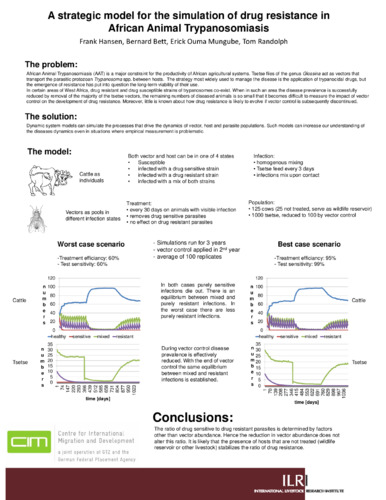A strategic model for the simulation of drug resistance in African animal trypanosomiasis
Abstract
African Animal Trypanosomiasis (AAT) is a major constraint to the productivity of African agricultural systems, both where animals are used for dairy or meat production and where traction power is needed to cultivate the land. Tsetse flies of the genus Glossina act as vectors that transport the parasitic protozoan Trypanosoma spp. between hosts. The strategy most widely used to manage the disease is application of trypanocidal drugs, but the emergence of resistance has put into question the long-term viability of their use.
In certain areas of West Africa, drug resistant and drug susceptible strains of trypanosomes co-exist. When in such an area the disease prevalence is successfully reduced by removal of the majority of the tsetse vectors, the remaining numbers of diseased animals is so small that it becomes difficult to measure the impact of vector control on the development of drug resistance. Moreover, little is known about how resistance is likely to evolve if vector control is subsequently discontinued.
Dynamic system models can simulate the processes that drive the dynamics of vector, host and parasite populations. Such models can increase our understanding of the diseases dynamics even in situations where empirical measurement is problematic.
We describe a model in which cattle hosts are represented as individuals. Cattle can be infected by a drug resistant or drug susceptible strain of the pathogen, or a mix of both. Tsetse flies, represented as cohorts, can spread disease between hosts. The model incorporates processes that potentially alter the ratio of drug resistant to drug susceptible trypanosomes, such as reaction to medication, and keeps track of the proportions of drug resistance and drug susceptible strains in the trypanosome population.
The model is strategic in the sense that it doesn't attempt to represent a particular situation in a particular region, but more generally aims to improve our understanding of a situation in which empirical science is constrained.

